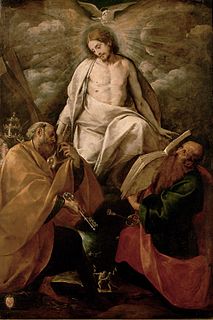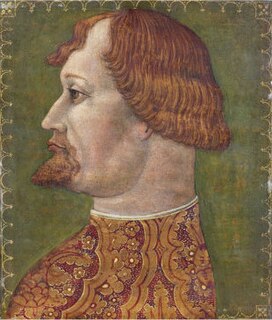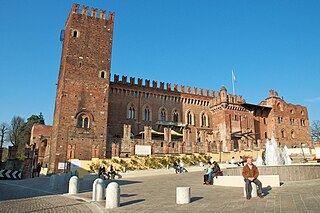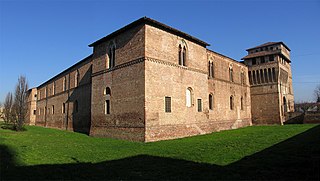This article needs additional citations for verification .(May 2015) (Learn how and when to remove this template message) |

The Castello Visconteo or Visconti Castle is a castle in Pavia, Lombardy, northern Italy.

Pavia is a town and comune of south-western Lombardy in northern Italy, 35 kilometres south of Milan on the lower Ticino river near its confluence with the Po. It has a population of c. 73,000. The city was the capital of the Kingdom of the Lombards from 572 to 774.

Lombardy is one of the twenty administrative regions of Italy, in the northwest of the country, with an area of 23,844 square kilometres (9,206 sq mi). About 10 million people, forming one-sixth of Italy's population, live in Lombardy and about a fifth of Italy's GDP is produced in the region, making it the most populous and richest region in the country and one of the richest regions in Europe. Milan, Lombardy's capital, is the second-largest city and the largest metropolitan area in Italy.

Italy, officially the Italian Republic, is a country in Southern Europe. Located in the middle of the Mediterranean Sea, Italy shares open land borders with France, Switzerland, Austria, Slovenia and the enclaved microstates San Marino and Vatican City, as well as a maritime border with Croatia. Italy covers an area of 301,340 km2 (116,350 sq mi) and has a largely temperate seasonal and Mediterranean climate. With around 61 million inhabitants, it is the fourth-most populous EU member state and the most populous country in Southern Europe.
Contents
It was built in 1360 by Galeazzo II Visconti, soon after the taking of the city, a free city-state until then. The credited architect is Bartolino da Novara. The castle used to be the main residence of the Visconti family, while the political capital of the state was Milan. North of the castle a wide park was enclosed, also including the Certosa of Pavia, founded 1396 according to a vow of Gian Galeazzo Visconti, meant to be a sort of private chapel of the Visconti dynasty. The Battle of Pavia (1525), climax of the Italian Wars, took place inside the castle park.

Galeazzo II Visconti was a member of the Visconti dynasty and a ruler of Milan, Italy.
A city-state is a sovereign state, also described as a type of small independent country, that usually consists of a single city and its dependent territories. Historically, this included cities such as Rome, Athens, Carthage, and the Italian city-states during the Renaissance. As of 2019, only a handful of sovereign city-states exist, with some disagreement as to which are city-states. A great deal of consensus exists that the term properly applies currently to Monaco, Singapore, and Vatican City. City states are also sometimes called microstates which however also includes other configurations of very small countries, not to be confused with micronations.

Bartolino (Bertolino) Ploti da Novara was an Italian military architect and engineer.
It presently houses the Civic Museums of Pavia (Museo Civici di Pavia) including the Pinacoteca Malaspina, Museo Archeologico and Sala Longobarda, Sezioni Medioevale e Rinascimentale Quadreria dell’800 (Collezione Morone), Museo del Risorgimento, Museo Robecchi Bricchetti, and the Cripta di Sant’Eusebio. [1]





















